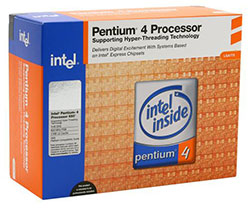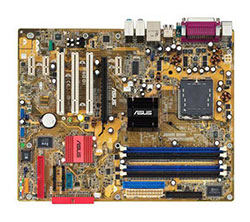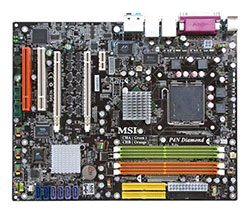Buyer's Guide: Mid-Range to High-End, May 2005
by Jarred Walton on May 23, 2005 5:30 PM EST- Posted in
- Guides
Intel Recommendations
Intel Processors
There are always people who continue to prefer Intel processors for whatever reason. We feel that AMD has the upper hand right now - both in price as well as performance - but there are merits to the Intel platform. We've said it many times before, but let us reiterate that anyone interested in serious 3D gaming should just forget the Intel chips for now. It's really that cut and dry, unfortunately. The dual core Pentium D 8xx parts should also show up at retail any time now, and since multitasking is probably the best argument for Intel enthusiasts, we would seriously recommend waiting for those chips. Those looking to purchase an Intel system now still need to make the decision between 5xx with higher clock speeds and 6xx with more features. (The 5xx chips with EM64T are not yet available either.) In the end, we still can't offer a "one size fits all" choice, so we're declaring it a draw between the two processor lines. You can get a similarly priced 5xx or 6xx chip for both price points, but we're going with 5xx for the Mid-Range and 6xx for the High-End.Intel Mid-Range Recommendation
Processor: Pentium 540J 3.2GHz 1MB (Retail) - Prescott core
Price: $213 Shipped
It's telling that the most reasonably priced CPU from Intel continues to be their 3.2 GHz part. Wasn't the 3.2C originally launched almost two years ago? Anyway, faster Pentium chips are available, but the price scales rapidly. You could even opt for the 3.0 GHz 530J and still get reasonable performance - particularly with overclocking. Although, make sure that you get an appropriate motherboard if you plan on overclocking with an Intel chipset! The 6xx series counterpart to the 540J is the 630, which comes clocked at 3.0 GHz, costs $15 more, and comes with 64-bit support and more cache. If you want to overclock, we'd suggest forgetting 64-bit support and sticking with the 5xx series - doubling the L2 cache does not help with overclocking, needless to say. Still, feel free to try your luck.
Intel High-End Recommendation
Processor: Pentium 650 3.4GHz 2MB (Retail) - Irwindale/Prescott 2M core
Price: $412 Shipped
With the High-End Intel setup, we feel that it only makes sense to grab a 64-bit capable processor. Not everyone is going to need the ability to run XP-64, but if you're going to spend over $400 on a CPU, we think that you're more likely to be part of the bleeding edge who likes to try all the latest and greatest hardware and software. If you disagree or still feel that clock speed is king, the Pentium 560J runs at 3.6 GHz and omits support for EM64T, all while costing $7 (wow!) less. (The 561 should arrive some time in the next couple of months if you're interested in 64-bit support without the 2MB cache.)
The difference between the Mid-Range and High-End Intel processors ends up being just 400 MHz - only 12% to 13% faster in terms of clock speed. Of course, you could also take the CPU recommendation up one more step to the 570J or 660, which would add another $200. (We don't think that it's worth it either.) It's interesting to note that we've had reasonable success running most recent Prescott "J" chips with a 14X multiplier and 1066FSB. All new Pentium 4 processors support EIST, which allows them to reduce the CPU speed and voltages and drop down to 2.8 GHz on an appropriate motherboard. Most enthusiast motherboards allow you to lock the multiplier at 14X and run with the faster bus speed. 3.73GHz ends up outperforming everything including the 570J (due to the increased bus speeds and memory bandwidth, although it's basically a tie) while costing hundreds of dollars less, but nothing is guaranteed with overclocking and some people prefer the guaranteed performance at stock speeds.
Intel Motherboards
The best motherboards for Intel processors pretty much always use Intel chipsets. That may change with the new NVIDIA nForce 4 SLI chipset, but motherboards using the NVIDIA chipset are difficult to find at retail. Furthermore, the new dual core Pentium D processors will require a new chipset to work. That means Intel's 945 and 955 chipsets or the aforementioned nForce 4 SLI for 775. We're still waiting for widespread retail availability (as well as a price drop), which should hopefully come during the next couple of weeks. Newegg and ZipZoomFly (and a few others) have the ASUS P5WD2 (955X) and the MSI P4N Diamond (nF4 SLI), but both cost nearly $250 right now and you still can't find dual core processors. All these factors combined make it difficult to recommend any current socket 775 motherboard, but it's not impossible. There are many good motherboards for both platforms, so just because we don't specifically mention a motherboard, it doesn't mean it's a poor choice. Rather than trying to list the pros and cons of dozens of motherboards, we would suggest that you visit our forums if you want further advice. (Or you can always try emailing us.)Intel Mid-Range Recommendation
Motherboard: ASUS P5GD1
Price: $110 Shipped
There are several things that we're looking for in a decent socket 775 motherboard for a Mid-Range PC. First, we want HD audio and GbE - preferably on the PCIe bus for GbE. We've talked about the difference in price between DDR and DDR2 in the past, but now prices have dropped to the point where that isn't as big of a concern; what's important now is that the board needs to have four memory slots of the same type, since you can't use DDR and DDR2 at the same time. We've never been fans of combo memory designs, as they usually involve a compromise, and that's the case here. Additional features are welcome, but not required, and in the end, we're back to the same ASUS motherboard from our last Mid-Range Guide, albeit with a reduced price. The P5GD1 meets all of the above, and adds in more PATA connectors, good overclocking support, ASUS' proven reliability, and it's still one of the cheaper 775 boards.
The usual suspects are all there with competing products, but they all cost more without offering a whole lot in the way of improved features. The EPoX EP-5EPA+ did well in our roundup, but it's still just a similar product to the ASUS at a higher price. The same goes for the Abit GD8, while the AG8 adds Firewire ports (the only real omission on the ASUS board). The only board that offers something really different from the ASUS is the MSI 915P Neo2 Platinum. It supports DDR2 memory and also has a Firewire connection. Why would you want DDR2 memory? We'll cover this more in the RAM section, but the short answer is that the price/performance for overclocking setups is pretty good.
Intel High-End Recommendation
Motherboard: MSI P4N Diamond
Price: $229 Shipped
Our High-End board is one of the most expensive motherboards that we've ever recommended, and we're giving this recommendation with quite a few caveats. First, we assume that dual core support will work properly (we haven't officially tested it). The bigger factor is that it's one of the few current Intel platform motherboards to support SLI, so if you want Intel and you want the most powerful gaming configuration possible, then you want an nForce 4 SLI board. If you can find a Pentium D to go with this board, our misgivings are not as severe, as certain multitasking tests show that Intel can still beat AMD in that area - particularly when you consider that Pentium D should be available before and cost significantly less than Athlon X2. Just remember that you're spending $70 extra on the motherboard, which certainly cuts into the cost benefits of the platform.
If you want SLI and you don't want to wait for Pentium D to show up at retail, then you're better off with the AMD platform. If you still insist on Intel, that's your right, but most people would say that you're being stubborn. Then again, the cost of a Pentium 4 540J (3.2 GHz) now and a Pentium D 830 (3.0 GHz) later would still be less than the current suggested cost of the cheapest Athlon 64 X2. (My, how the times have changed.) Coupled with the current release schedule - Pentium D should appear at retail several months before Athlon X2 - the High-End, early adopter who demands multitasking performance will probably want to give Intel options some thought. You could always look to SMP workstation setups as well, but then you lose SLI, and that's not something that we want to do for our High-End recommendation.
We should also mention the other SLI option for Intel, the ASUS P5ND2-SLI Deluxe. We've tested that board (along with the P5WD2) and it certainly offers a lot of features. The reason why we didn't recommend it over the MSI board is that it costs an extra $50. Perhaps the MSI board will support DDR2 RAM running at DDR2-1000 speeds and perhaps not. However, most of us don't feel that the additional percentage points gained in performance are worth the increased cost. For gamers, full SLI support is far more important than increased memory speed support.














60 Comments
View All Comments
CP5670 - Wednesday, May 25, 2005 - link
You can still get Mitsubishi 2070s (I got a new one for $600 about three weeks ago), although they are out of production and are somewhat hard to find.JarredWalton - Wednesday, May 25, 2005 - link
44 - Venice and Winchester seem to be the same chip, only with SSE3 enabled on Venice. I don't think it matters much for games right now, but with the difference only being $4 now, go for it. (At the time I wrote this Guide, Winchester retail chips were $20 less than Venice retail chips, which is harder to justify.)47 - I've emailed a few people about this, but basically there just aren't any improvements to CRTs coming out these days. You can still find some Dell, HP, etc. monitors that use the same tube as the NEC FE2111SB, and it's a good tube overall. The Mitsubishi 2070 still boasts the best specs I'm aware of (140 kHz horizontal scan rate and 2048x1536 resolution).
If you want a CRT, by all means get one. The Samsung 997DF is still a decent 19" model for around $210, though it's not perfectly flat. NEC FE991SB are also good, though they cost more than the Samsung. If you can find a discount on a Dell, HP, etc. CRT and it sports an aperture grille, it's probably going to be similar enough to the NEC/Mitsubishi models that you wouldn't notice other than the exterior.
Personally, I'm just tired of large CRTs, and I've recommended them in so many Guides (without any change) that it's time to move on. I'll continue to mention them, but I don't recommend them anymore for a lot of people.
CrimsonChaos - Wednesday, May 25, 2005 - link
Great guide!I was recently considering buying a system inbetween a mid-range and high-end computer. This would have been a tremendous help to me as I started the researching process.
Just a quick question -- why no PC Power & Cooling power supply for a high-end system? That too expensive even for the biggest enthusiast (aka money-waster)??
Also, going to add any normal CRT recommendations to the "Display" part?
Olaf van der Spek - Wednesday, May 25, 2005 - link
Re: 16> and I feel about the same for audio.
That's not a very strong argument.
But because audio is always integrated while video isn't, it's indeed simpler to add one later.
ceefka - Wednesday, May 25, 2005 - link
#43 Reapsy00,About every new CPU, mobo/chipset, graphicscard, RAM, LCD/CRT mentioned here has been benched, just not in this same article.
Also, recommendations here were winners in past benchmarkings before this article.
You'll even find links to benchmarks in the buyers guide. In my opinion AT has got it nailed pretty good.
dmaduram - Wednesday, May 25, 2005 - link
Kudos to Jarred for such an excellent guide -- it's quite informative!Just two quick questions -- first of all, with regard to gaming, is there an advantage in selecting a AMD-Venice core instead of a AMD-Wichester core? I was unsure on what specific applications recieved a boost from Venice's "SSE3" support.
Secondly, d'you know if there are any disadvantages in purchasing a Venice core instead of the recommended Wichester core? There's only a 4-dollar difference in price on NewEgg, so I was wondering which one I should buy for my gaming box :)
Reapsy00 - Wednesday, May 25, 2005 - link
You see lots of these buyer's guides on different sites, AT should take it further and build the system's and benchmark 'em.Calin - Wednesday, May 25, 2005 - link
No problem, TujanI wouldn't choose a VIA miniITX platform - the 1GHz processors are quite faster than the older 700-800MHz ones. However, their very size forces them to be niche systems.
If I would like a computer in my car, a MiniITX would be the best choice. But for a stand alone, I very much prefer upgradable PC technology
R3MF - Tuesday, May 24, 2005 - link
ah well, my new shuttle SN25P with a 3200 Venice, 6600GT (£98.00), and 250GB 7200.8 doesn't look too shabby.it even has onboard via-envy sound, and will be even better with a 7800GT and dual-core X2 early next year.
i am happy.
JarredWalton - Tuesday, May 24, 2005 - link
35 - Thanks. I wasn't aware of that. (I hate it when manufacturers do that!) Anyway, I added a comment about this in the article. Basically, I'm saying that RAM with TCCD blanks is still a great choice for overclockers looking for maximum clock speeds.